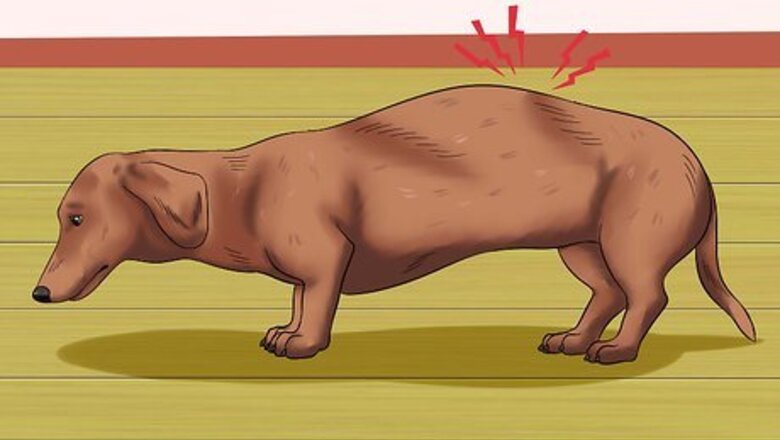
views
X
Research source
One look at the body shape of the dachshund, with that long back and little legs, immediately gives the impression that there is a lot of strain on the dog's spine. Add in factors such as how difficult those little legs make it to go up and down stairs and you begin to have an inkling of the extreme forces at work on the dachshund's back.[2]
X
Research source
Because of this high risk of back injury, it is important to be able to identify if your dog is having problems and to know what to do if it indeed it is.
Identifying Signs of Back Pain

Keep an eye out for subtle symptoms of back pain. These can range widely from a dog in mild discomfort that appears quieter than usual, to the dog with an explosive disc protrusion that suddenly goes off its back legs and is paralyzed. Some subtle signs of back pain that can clue you in that there is a potential problem include: Reluctance to move: The pain associated with back problems means the dog is unwilling to move and may stand in one spot, head lowered. He may yelp or cry out when you try to put his collar on. Some dogs refuse to eat or drink because lowering their head to the bowl is painful. Arched back: Many dogs with back pain adopt a hunched back stance, and stand stiffly, guarding their movements. They may also sit with their hips turned to one side instead of straight. Altered behavior: The dog may be reluctant to jump up onto a favorite sofa, or not be able to go upstairs to bed.

Take your dog's response to pain seriously. Back pain is immensely painful and many dogs will vocalize, cry out, and whimper in response to the pain. They may even cry out just in anticipation of the pain when they are asked to move. Your dog is not just being dramatic when it yelps in pain.

Take a dog with sudden paralysis to the vet immediately. If pressure to the spinal cord is severe enough, it can cause nerve damage. This most commonly affects the back legs. The dog may not be able to stand, and when it tries to move it "wheelbarrows" forward, its front paws pulling its back end along. A dog with sudden paralysis needs to be seen by a veterinarian in order for the spinal damage to be assessed and treated. Severe paralysis can interfere with bladder and bowel function, and the dog may either become incontinent or it may be unable to empty its bladder. Your veterinarian should give you guidance about how to deal with this problem.
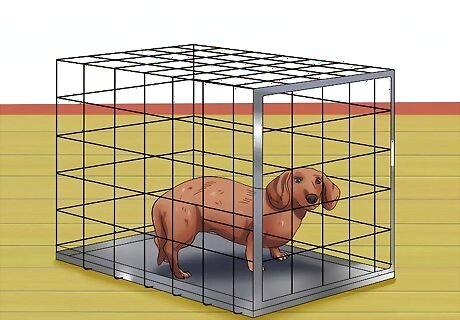
Force your dog to stop moving. If your dachshund shows sign of back pain, then you should restrict its movements so that it is forced to rest. Do not allow it to move around the house, instead restrict it to a puppy crate while you make an appointment with the vet. When you take the dog to the vet, carry it to the car and carry it into the vet's office, as moving awkwardly could cause a grumbling disc to rupture.
Diagnosing Back Pain
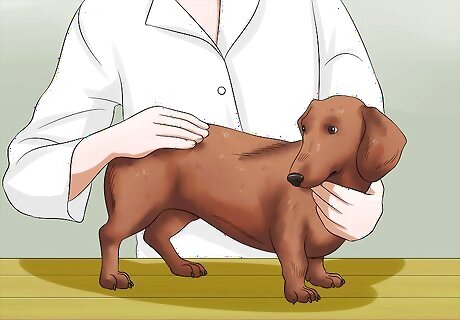
Take your dog for a veterinary exam. Your vet will perform a physical examination, which includes being alert for other problems that can cause pain and mimic back ache. The vet will support the dog's back end and turn the back of the paw so that it rests on the ground. This is to check the dog is aware the paw is in the wrong position and correct it. Not to do so could indicate nerve damage. The vet will also check for other nerve reflexes, such as the ability to feel pain in the toes, as an indication of whether there is nerve damage or not. The vet will gently feel along the spine, being especially alert for local areas of tenderness and muscle "fasciculation," which is where the muscles twitch because they are sensitized to pain.

Consent to your vet giving the dog an x-ray. If back pain is confirmed, the vet may suggest imaging to check what is causing the pain. Sources of pain include disc disease, spinal arthritis, spondylitis (infection in the vertebra), inflammatory nerve disease, muscle sprains and strains. A diagnostic test commonly used at veterinary clinics is to take x-rays of the spine. Each section of the back is x-rayed in turn (depending on where the suspected damage is), such as the neck, chest, and lower back. Two views are usually taken of each area so as to provide a cross reference: One view taken from the side (the lateral) and one from above or below (the dorso-ventral or ventro-dorsal). Radiography can provide helpful information about the bones of the spine and the spaces between them, but it cannot provide a picture of the spinal cord itself. For this more advanced imaging methods are needed. A limitation of x-rays is they can be misleading. For example, a narrowed space between two vertebra is abnormal and suggest that the disc is diseased. However, the disc may have ruptured harmlessly to one side and avoided pressurizing the spinal cord. Thus, x-rays can give a clues, which can be interpreted in the light of clinical signs as giving a diagnosis.
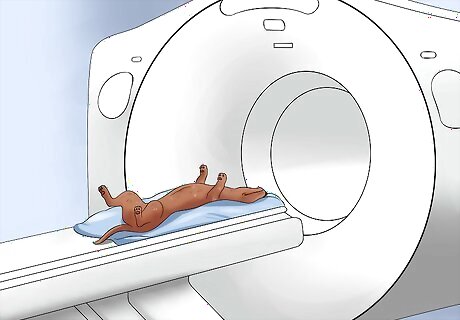
Ask your veterinarian about getting an MRI or CT scan instead of an x-ray. More sophisticated imaging techniques, where available, have taken over from x-rays. These sophisticated techniques can visualize the spinal cord itself. Thus if a disc has prolapsed into the spine, the clinician will be able to see the "waistline" in the spine where it is compressed. This is vital information if specialist decompression surgery is being considered, as it allows the surgeon to know exactly which discs are involved, so they operate in the correct place. Unfortunately, MRI and CT scans are costly. In addition, the dog also needs to be anesthetized so that it keeps still in the scanner. This will have an additional cost, as well as a further health risk for the dog.
Preventing Back Problems
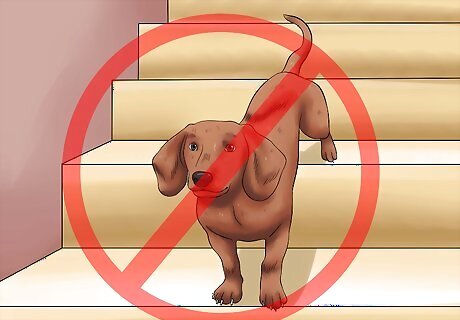
Prevent your dachshund from jumping off furniture or running up and down stairs. As already mentioned, dachshunds are prone to back problems because of the double whammy of prematurely aging discs and their body shape. A sensible precaution that any dachshund owner should consider is to stop their dog running up and down stairs as this strains the spine. Consider putting up dog gates at the top and bottom of stairs. This will stop the dog from going up or down without your supervision.
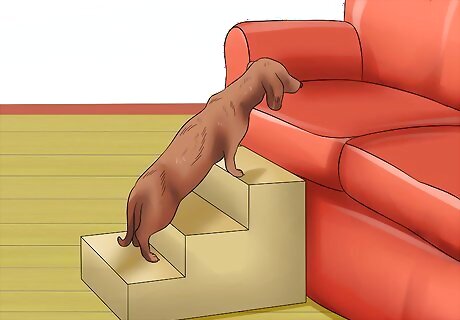
Help your dog get up on furniture. Consider adding dog stairs to your bed if your dog sleeps with you. These are small sets of stairs that allow a dog with short legs to get up on a surface it can't jump onto. You can also add them to the front of your couch or any other piece of furniture that you want to give your dog access to.
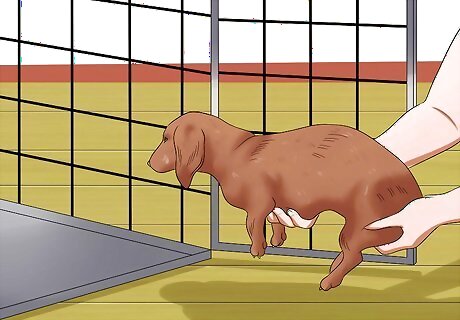
Force a slightly injured dachshund to rest. If your dachshund is showing signs of back pain, be sure to confine them to a puppy crate for strict rest. In cases of minor injury, this will give the inflammation in the back a chance to subside.
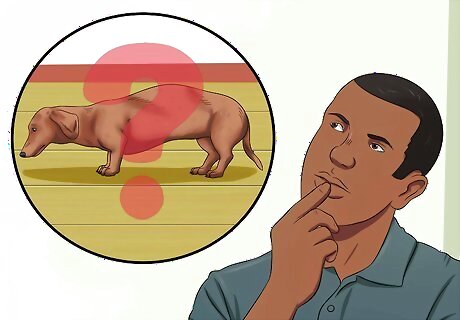
Understand why dachshunds have such high rates of back injuries. Dachshunds are prone to inter-vertebral disc disease or more simply "slipped discs." To understand why disc disease can be so painful, it helps to understand the anatomy of the back. The spine is not a rigid rod, but has some flexibility because it is made up of smaller individual bones called vertebrae. There is a hollow 'arch' to each vertebra through which the spinal cord passes. Each vertebra is cushioned from its immediate neighbor by a disc, which is like a spongy doughnut. The discs articulate with the solid body of the vertebra, but should not intrude on the spinal cord at all. Each disc has a spongy center (nucleus pulposus) surrounded by a more fibrous body (annulus fibrosus). Damage to the disc can happen when the liquid core becomes solid and its cushioning effect is lost, or if the fibrous body ages and becomes brittle and prone to cracking or rupture. When force is applied (such as when the dachshund jumps off a chair or twists awkwardly) the disc is prone to shear and tear. If the now-stiff nucleus pulposus presses upwards it puts pressure on the spinal cord, which results in pain. If the disc fails catastrophically the contents of the nucleus pulposus can be forced explosively into the spinal cord and cause nerve damage. Dachshunds, along with breeds such as the Pekinese and Shih Tzu, are genetically predisposed to premature ageing of the cartilage part of the disc. This, along with the structure forces at work on the spine, mean they are prone to back pain, from ages as young as 2 - 4 years.




















Comments
0 comment